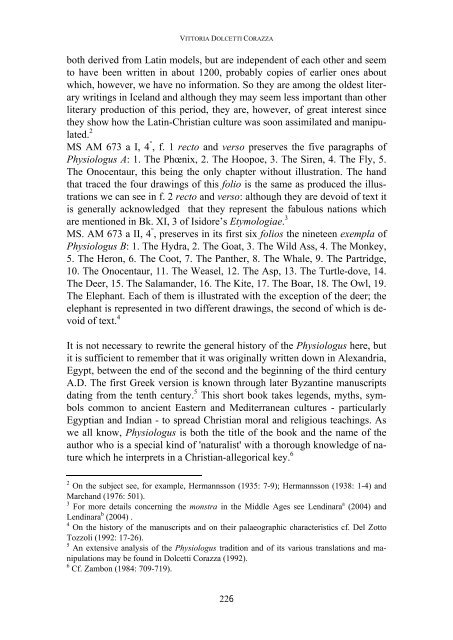Crossing paths in the Middle Ages: the Physiologus in Iceland - Lear
Crossing paths in the Middle Ages: the Physiologus in Iceland - Lear
Crossing paths in the Middle Ages: the Physiologus in Iceland - Lear
Create successful ePaper yourself
Turn your PDF publications into a flip-book with our unique Google optimized e-Paper software.
VITTORIA DOLCETTI CORAZZA<br />
both derived from Lat<strong>in</strong> models, but are <strong>in</strong>dependent of each o<strong>the</strong>r and seem<br />
to have been written <strong>in</strong> about 1200, probably copies of earlier ones about<br />
which, however, we have no <strong>in</strong>formation. So <strong>the</strong>y are among <strong>the</strong> oldest literary<br />
writ<strong>in</strong>gs <strong>in</strong> <strong>Iceland</strong> and although <strong>the</strong>y may seem less important than o<strong>the</strong>r<br />
literary production of this period, <strong>the</strong>y are, however, of great <strong>in</strong>terest s<strong>in</strong>ce<br />
<strong>the</strong>y show how <strong>the</strong> Lat<strong>in</strong>-Christian culture was soon assimilated and manipulated.<br />
2<br />
MS AM 673 a I, 4 ° , f. 1 recto and verso preserves <strong>the</strong> five paragraphs of<br />
<strong>Physiologus</strong> A: 1. The Phœnix, 2. The Hoopoe, 3. The Siren, 4. The Fly, 5.<br />
The Onocentaur, this be<strong>in</strong>g <strong>the</strong> only chapter without illustration. The hand<br />
that traced <strong>the</strong> four draw<strong>in</strong>gs of this folio is <strong>the</strong> same as produced <strong>the</strong> illustrations<br />
we can see <strong>in</strong> f. 2 recto and verso: although <strong>the</strong>y are devoid of text it<br />
is generally acknowledged that <strong>the</strong>y represent <strong>the</strong> fabulous nations which<br />
are mentioned <strong>in</strong> Bk. XI, 3 of Isidore’s Etymologiae. 3<br />
MS. AM 673 a II, 4 ° , preserves <strong>in</strong> its first six folios <strong>the</strong> n<strong>in</strong>eteen exempla of<br />
<strong>Physiologus</strong> B: 1. The Hydra, 2. The Goat, 3. The Wild Ass, 4. The Monkey,<br />
5. The Heron, 6. The Coot, 7. The Pan<strong>the</strong>r, 8. The Whale, 9. The Partridge,<br />
10. The Onocentaur, 11. The Weasel, 12. The Asp, 13. The Turtle-dove, 14.<br />
The Deer, 15. The Salamander, 16. The Kite, 17. The Boar, 18. The Owl, 19.<br />
The Elephant. Each of <strong>the</strong>m is illustrated with <strong>the</strong> exception of <strong>the</strong> deer; <strong>the</strong><br />
elephant is represented <strong>in</strong> two different draw<strong>in</strong>gs, <strong>the</strong> second of which is devoid<br />
of text. 4<br />
It is not necessary to rewrite <strong>the</strong> general history of <strong>the</strong> <strong>Physiologus</strong> here, but<br />
it is sufficient to remember that it was orig<strong>in</strong>ally written down <strong>in</strong> Alexandria,<br />
Egypt, between <strong>the</strong> end of <strong>the</strong> second and <strong>the</strong> beg<strong>in</strong>n<strong>in</strong>g of <strong>the</strong> third century<br />
A.D. The first Greek version is known through later Byzant<strong>in</strong>e manuscripts<br />
dat<strong>in</strong>g from <strong>the</strong> tenth century. 5 This short book takes legends, myths, symbols<br />
common to ancient Eastern and Mediterranean cultures - particularly<br />
Egyptian and Indian - to spread Christian moral and religious teach<strong>in</strong>gs. As<br />
we all know, <strong>Physiologus</strong> is both <strong>the</strong> title of <strong>the</strong> book and <strong>the</strong> name of <strong>the</strong><br />
author who is a special k<strong>in</strong>d of 'naturalist' with a thorough knowledge of nature<br />
which he <strong>in</strong>terprets <strong>in</strong> a Christian-allegorical key. 6<br />
2 On <strong>the</strong> subject see, for example, Hermannsson (1935: 7-9); Hermannsson (1938: 1-4) and<br />
Marchand (1976: 501).<br />
3 For more details concern<strong>in</strong>g <strong>the</strong> monstra <strong>in</strong> <strong>the</strong> <strong>Middle</strong> <strong>Ages</strong> see Lend<strong>in</strong>ara a (2004) and<br />
Lend<strong>in</strong>ara b (2004) .<br />
4 On <strong>the</strong> history of <strong>the</strong> manuscripts and on <strong>the</strong>ir palaeographic characteristics cf. Del Zotto<br />
Tozzoli (1992: 17-26).<br />
5 An extensive analysis of <strong>the</strong> <strong>Physiologus</strong> tradition and of its various translations and manipulations<br />
may be found <strong>in</strong> Dolcetti Corazza (1992).<br />
6 Cf. Zambon (1984: 709-719).<br />
226

















